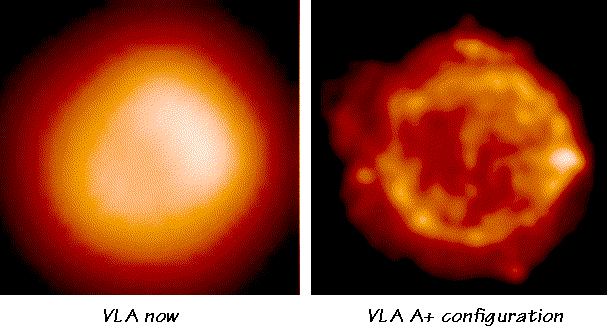
There is a serious gap in u-v coverage between the 35-km longest baseline of the VLA and the 200-km shortest baseline of the VLBA. We plan to bridge this gap by allowing some VLA, some VLBA and some new antennas to be used interchangeably as members of either array. These will (a) increase the resolution of the VLA at all frequencies and enlarge the range of resolutions over which it has ``scaled-array capability", (b) improve the dynamic range, field of view and extended-source sensitivity of the VLBA, and (c) provide the VLBA with a ``scaled-array" capability similar to the VLA's, which it presently lacks.
New antennas would be built in New Mexico and Arizona to make the density of u-v coverage in the 40-400 km baseline range the same as that in the VLBA now beyond 400 km. The first step would be to complete the ``Pie Town ring" around the VLA by adding antennas near Dusty, NM and Bernardo, NM. (Linking just the Pie Town antenna to the VLA would double the resolution of the A configuration for northern sources only. Linking the Dusty and Bernardo antennas extends this capability to the whole sky.) The second step would be to add further antennas in the ``Los Alamos ring": two possible sites are near Holbrook, AZ and Vaughn, NM. The VLA's delay and fringe rotation systems would be expanded to correlate these signals in real time with the present A configuration (processing would be done at the new 32-station VLA correlator).
Figure 1.1:
(left) An image obtained by using the full u-v coverage of the
VLA in the A configuration at  6cm to sample a model derived
from the radio structure of the supernova remnant Cassiopeia A,
rescaled to a distance of 1 Mpc. Only a rudimentary indication of
shell structure is visible at this resolution (FWHM
6cm to sample a model derived
from the radio structure of the supernova remnant Cassiopeia A,
rescaled to a distance of 1 Mpc. Only a rudimentary indication of
shell structure is visible at this resolution (FWHM 
 ).
).
(right) An image obtained by sampling the same model with the
full u-v coverage proposed for the A+ configuration. The FWHM of the
synthesized beam is about 8 times smaller, revealing many details of
the shell and filament structure. Neither simulation is
noise-limited.
Figure 1.1 illustrates how the
expanded u-v coverage in the A+ configuration would improve the
imaging of a ``twin'' of the Cas A supernova remnant at the distance
of about 1 Mpc, for example in M 31. The angular extent of the
remnant would be about  . The left panel shows the image
that could be obtained at
. The left panel shows the image
that could be obtained at  6cm with the present VLA A
configuration. The right panel shows the dramatic improvement
obtainable with the proposed A+ configuration.
6cm with the present VLA A
configuration. The right panel shows the dramatic improvement
obtainable with the proposed A+ configuration.
Sub-arc-second resolution observations with the present VLA are possible only at the higher frequencies where the brightness sensitivity needed to detect nonthermal phenomena may be inadequate because of the source spectra. These frequencies may also be inappropriate for any projects in which Faraday depth effects, wide-band spectral shapes, or low-frequency spectral lines are needed to probe source physics at these resolutions. There are also many instances (Chapter 3) where studies of normal stellar radio emission will benefit greatly from increasing both the resolution and sensitivity of the VLA together at higher frequencies.
The reconfigurability of the VLA (its capacity for ``scaled array"
observations with the same angular resolution at several frequencies)
has been vital to its astrophysical success. This distinctive
capability of the VLA is now present across the whole frequency
range from 330 MHz to 22 GHz only at resolutions near  .
No problem that requires higher angular resolution than
.
No problem that requires higher angular resolution than  and
full frequency coverage can now be tackled in scaled-array mode. This
situation changes dramatically if we can add data from longer
baselines in the A+ configuration or the VLBA.
and
full frequency coverage can now be tackled in scaled-array mode. This
situation changes dramatically if we can add data from longer
baselines in the A+ configuration or the VLBA.
Finally, we note that the availability of optical imagery at  resolution from the Hubble Space Telescope is emphasizing the need for
better coverage of this resolution regime over a full range of radio
frequencies. This resolution falls squarely in the ``uncovered gap"
between the VLA and VLBA at just the frequencies where imaging would
be least corrupted by atmospheric and ionospheric phenomena.
resolution from the Hubble Space Telescope is emphasizing the need for
better coverage of this resolution regime over a full range of radio
frequencies. This resolution falls squarely in the ``uncovered gap"
between the VLA and VLBA at just the frequencies where imaging would
be least corrupted by atmospheric and ionospheric phenomena.